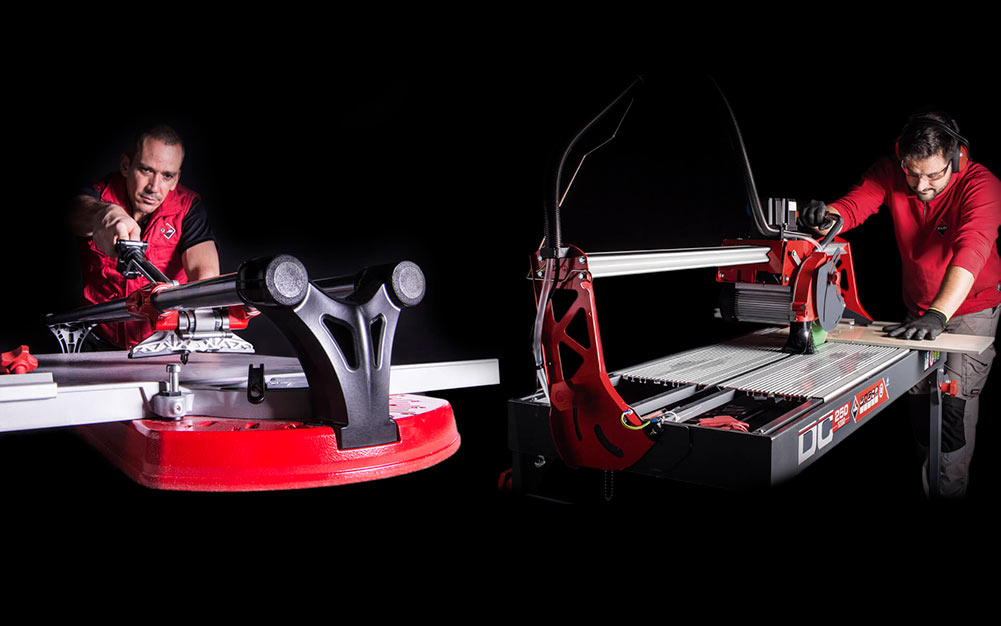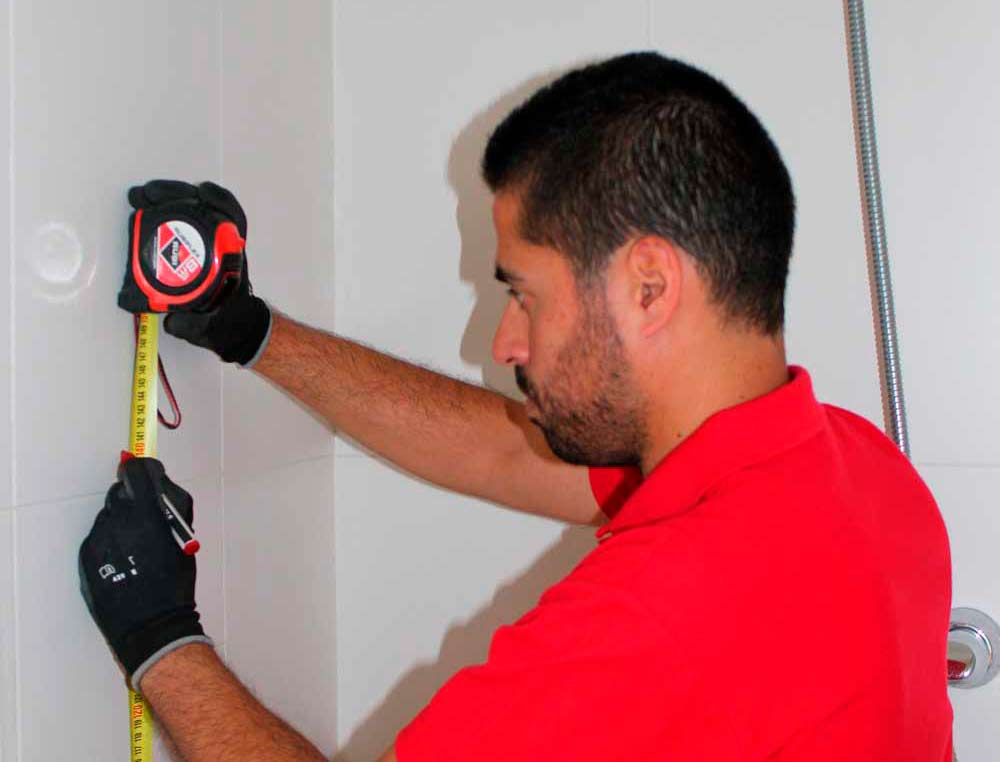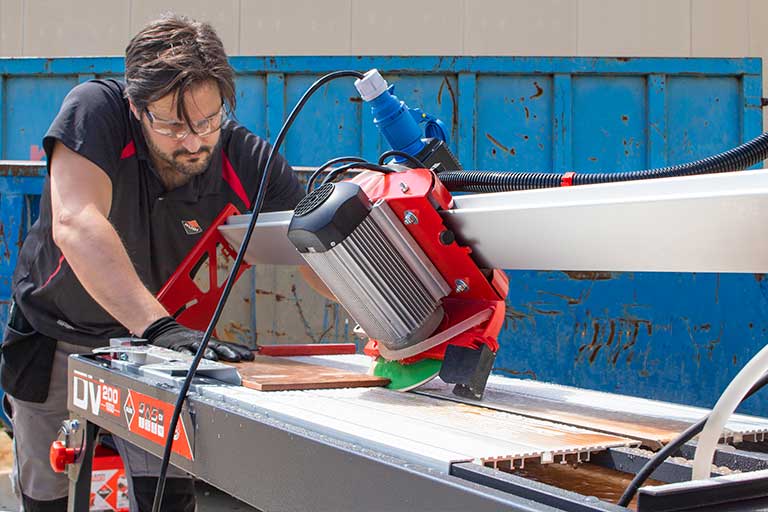Tile cutter vs wet saw? These are the two best tile cutting tools for tile setters. But which you should choose depends on the specific job at hand, the materials you’re cutting, and the space to work on. That’s why today, we’re bringing you our guide for choosing the best tool for your project. When it comes to the great tile cutter vs wet saw debate, we’re here to help. Let’s get started.
Let’s paint a picture. You’re replacing the tile kitchen counter. Or maybe it’s the tile bathroom floor. But your tiles just won’t line up. After an hour of frustration and a few choice words, you’re ready to call in the professionals. Good move, right?
Stop right there. Tile cutting isn’t difficult. Just because you’re an amateur tile setter doesn’t mean you should shy away from cutting some tile. It all comes down to choosing the right tool for the job.


Tile Composition
Tile comes in all different varieties. Ceramic tile, clay tile, and porcelain tile are the tiles you’ll commonly see at the store. Though these three types only scratch the proverbial tile surface.
Ceramic tile is made from sand, water, and clay. The materials are molded into a square and then baked in a kiln to remove moisture.
Porcelain tile is made from a denser type of clay than ceramic tile. Clay tiles are entirely clay. Ceramic, porcelain, and clay tiles are either glazed for inside use or unglazed for roofing.
Tile types such as glass, cork, concrete, and stone are used for any number of other applications. There’s no rule dictating which tile you can or can’t use for a project. Though some tile does hold up better in certain environments.
Measuring Your “Floor Plan”

Your “floor plan” refers to where you’re laying tile. Every project comes with unique spatial challenges. Sometimes you need more tile, sometimes less, and other times you need to cut tile.
Accurately measuring your floor plan is imperative for choosing the correct amount of tiles for your project. Measure the entire floor plan’s boundaries, diagonal interiors, width, and height. Next, measure one square of sample tile. Use those numbers to calculate how many tiles you’ll need for your entire project.
Don’t forget to account for abnormal boundaries. Order extra tile to ensure you have plenty to cut when it comes time to assemble the puzzle pieces.
Cutting Tile
Chances are almost certain you’re not working with perfectly straight boundaries that are a multiple of your tile size. Cutting tile is the only way to make most projects work.
Your two best tile cutting options are tile cutters and a wet saw. Tile cutters generally take more time, less skill, but are more convenient. Wet saws take less time, more skill, but are less convenient.
Each is readily available through the RUBI store. Which you should choose is an entirely different story. Ready to learn the difference between tile cutters and wet saws? Let’s get started.
Tile Cutters
Everyone should have tile cutters in their toolbox. The cutters look somewhat like a car jack with a bar that runs from top to bottom. Tiles get placed inside the cutters and scored. The tiles break along the scored line.

Tile cutters by nature, take longer to set up and use than wet saws. You need to find your tile, place it inside the cutter, score the tile, and finally snap the tile along the score. What’s more, some harder tiles don’t score well, so choosing the proper scoring wheel is a must. For glass tile, for an instance, scoring glass can be done with any scoring wheel, but the one we recommend is 6mm and the RUBI Extreme.
There is a trick to scoring glass and that is to score lightly because putting too much pressure on the tile when you score can cause it to crack or give it a jagged edge. As you can see, breaking tiles along the score isn’t always easy. Sometimes the tile cutter won’t score deep enough. Other times the tile just doesn’t want to break. Expect to fight with more than a few tiles.
However, tile cutters have some serious benefits. They’re cheaper than wet saws, portable, and operation doesn’t take intricate skill. (Though you do need skill to line up your tiles.)
Tile cutters work best for either smaller projects, projects with straight borders, or projects with soft tiles. Smaller projects mean fewer tiles to cut, tile cutters can’t cut wavy lines, and softer tiles snap better after scoring.
Our website lists a number of different tile cutters. We carry different sizes made to accommodate any type of project. We also sell the maintenance materials, like lubrication, to keep your cutter smoothly working.

Wet Saws
Wet saws are best for large projects when your tile cutters aren’t cutting it (literally). Instead of relying on human power, wet saws use electricity. At first glance, a wet saw looks like a table saw. A rotating diamond blade cuts the tile while a guide keeps your tile straight.

Water sprays from around the cutting blade to ensure the tile doesn’t smoke and burn. Some tables come with a water reservoir while others can connect to a water source.
Wet saws cut tile extremely straight. The guide helps make perfect cuts so long as your hand doesn’t shake. With some skill, you can also cut tile into intricate shapes. While tile cutters can only cut straight, a wet saw can create curved tiles.
Wet saws can also cut harder tile materials. The diamond blade can cut the hardest varieties of tile. The wet saw is a must if you want to feel cutting glass tiles as if it was butter.
Compared to tile cutters, wet saws are best for large projects. You can cut tile faster, easier, and with more precision than manual tile cutters. The only price to pay is the set up and preparation of the working area. Wet saws are recommended for large rooms or rooms with complicated floor plans.
Skill and size are the wet saw’s main drawback. The units are typically large and take time to learn how to set them up properly. We must stress that you need to understand safety procedures before getting started. Please practice using a moving saw to cut straight lines and get familiar with the pressure and movement.
Buying a wet saw comes down to understanding what you need. Different saws come equipped for different jobs. Check out our wet saws inventory to see the available options.
Decide Your Project for Tile Cutter vs Wet Saw.
The guide above should serve as a good start in the tile cutter vs wet saw debate. Material, project size, and skill all factor into your choice. However, the best choice for your project isn’t always straightforward.
Sometimes money, time frame, tile type, and more can all influence which tool to choose. If you’re short on time, do you really have the luxury of ordering an expensive wet saw?
That’s where we’d like to help. Our experts would love to hear all about your project and help you decide between a tile cutter and a wet saw. We’ll take the time to ensure you’re buying the right tool for the job.
If you’re planning on tiling often, it might make sense to buy a tile cutter and a wet saw. You’re likely to run across situations where you’ll need each tool. It’s always best to have the proper tool for the job.
So if you’re ready to get started on your tiling project, get in touch with us. We can help you choose the best tool for your project. We guarantee you’ll leave satisfied.


We are tiling two affordable housing studio effeciency apartment bathrooms and kitchens, and making the countertops with tile. We don’t have a lot of money so are doing the work ourselves. We need to be able to cut 6 inch as well as 12-17 inch tiles. We saw a used 7 inch overhead wet tile saw, for a reasonable price….but do not know if it will work for larger tiles? Any recommendation would be greatly appreciated, thank you.
Do you folks need a 17″ tile cutter? We could offer you our Speed N 42 (REF#14949) which does cut 17″ tile and retails for about $155 online, depending of our distributor in your region. Potentially your wet saw should be good for running sizes up to 24.” Obviously not knowing the exact model you have in hand, if you need a tile cutter to cut 24″ pieces, then I would suggest our Rubi Speed N 62 (REF# 14985). Check out this link for further specs of this specific model recommended: https://www.rubi.com/blog/us/speed-n-tile-cutters-r630
Apologies for the late replay, but hoping this recommendation can help you and we wish you all the success on your current project.
I have a small bathroom, someone gave me enough porcelain tile to tile my bathroom, they measure 6” by 24”, if I only need to cut them the 6” way, would a smaller tile cutter work, what would you recommend?
If you only need to cut them on the short side than you should be fine with a smaller tile cutter. That said, you might want to keep the receipt because most installations will have a surprise cut necessary at some point that you didn’t foresee.